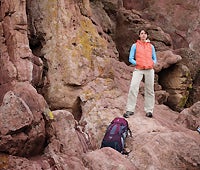How to Survive A Night Without Gear

Dropping most of your equipment at Kephart Shelter in Great Smokey Mountain National Park, you set out carrying food, water, and clothing for a 7.5-mile round-trip dayhike to the Charlies Bunion overlook. One of the most biologically rich forests on the continent eventually gives way to long views of verdant ridges. When you started out, the late-October sky looked leaden, and the air felt chilly. As you climbed nearly 2,000 feet on the Grassy Branch and Dry Sluice Gap Trails, light rain fell and soon changed to wet snow–not unusual for this time of year and elevation. Then the trail got more difficult to follow as the snow piled up and the Smokies’ namesake fog abruptly rolled in. Now darkness is falling, and even though you’d started back, you’re miles from the shelter and getting disoriented. Cold, wet, and exhausted, you’re suddenly facing a potentially life-threatening situation.
Stay put If you can’t discern the trail or landscape features, wait until daylight. Otherwise you risk becoming more lost, hypothermic, or even injured.
Layer up Change into any dry clothes and rainwear you packed, shedding the shirt you soaked while climbing.
Fill your bottle Dehydration makes you colder; make sure you have enough water for the night by adding wet snow to your bottle and stuffing it inside your jacket pocket to melt. Or set your bottle beneath a steady drip from a rock or vegetation.
Return to the Backpacking 101 home page.